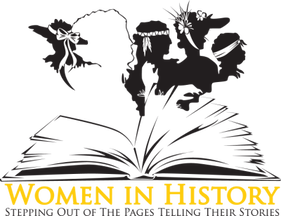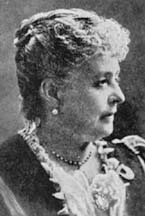WOMEN IN HISTORY - CAROLINE LAVINIA SCOTT HARRISON
Wife of Benjamin Harrison, 23rd President of the United States, was the first president-general of the newly formed DAR. An accomplished watercolorist, she designed and painted the Harrison state china and organized the White House china collection
DATE OF BIRTH
October 1, 1832
|
PLACE OF BIRTH
Oxford, Ohio
|
DATE OF DEATH
October 25, 1892
|
PLACE OF DEATH
White House, Washington, D.C. |
FAMILY BACKGROUND
Caroline Lavinia Scott, "Carrie," was the first wife of President Benjamin Harrison. She was the daughter of John Witherspoon Scott, a teacher and Presbyterian minister and Mary Potts Neal Scott. She had two sisters: Elizabeth Lord and Mary Spears and two brothers: John and Henry. Her family was Presbyterian. On October 20, 1853 she married Benjamin Harrison; they had one son, Russell Lord, (changed later to Russell Benjamin) Harrison and two daughters, Mary Scott Harrison McKee and an unnamed still born daughter. Caroline served as First Lady from 1889 to 1892.
EDUCATION
Caroline's parents were not only firm believers in education, but devoted their lives to educating young women and girls. As a young girl, she attended the Farmers College where her father taught. Here, she met and fell in love with Benjamin Harrison. In 1853 she graduated with a music degree from the Oxford Female Institute, which her father was instrumental in founding. While at the institute, Caroline developed her love for English Literature, drama, music, art and painting. While at Oxford and after graduation in Kentucky, Caroline taught music, home economics and painting to students.
ACCOMPLISHMENTS
Some regard her as the most underrated First Lady. While grandmotherly in appearance compared to her predecessor and successor, Frances Cleveland, she was greatly devoted to women's rights. She only agreed to assist John Hopkins raise money to start a medical school on the condition they must admit women. In 1890, the newly formed Daughters of the Revolution asked Caroline to become their President; in February 1892, Caroline gave the first recorded speech by a First Lady at the first congress of the DAR. As First Lady, she urged the American public to support their country by "buying American."
Her love of painting translated into her painting the White House china and also into her painting an orchid print made available to the women and girls of America. She began a preservation program for White House china, furniture and other artifacts which pioneered the necessity of historical preservation in the country.
The Harrisons inherited a White House which was rat infested and filthy. Caroline tried to expand the White House but did receive Congress's approval; instead, she did some remodeling and had electricity installed. However, the Harrisons were weary of this new energy source and avoided the switches. Caroline's efforts at White House expansion highlighted the need for more space to accommodate the increasing complexity of the role of the President.
She brought in the first Christmas tree to the White House in December of 1889; the Marine Band and Sousa revived dancing to the White House which had not been seen since Sara Polk was First Lady in 1845.
Caroline Harrison was deeply respected for her warmth, intelligence and artistic talent and for her devotion to her family and to her beliefs. During the country's centennial celebrations she became ill with tuberculosis and depression and died only four months before President Harrison's term ended.
Her love of painting translated into her painting the White House china and also into her painting an orchid print made available to the women and girls of America. She began a preservation program for White House china, furniture and other artifacts which pioneered the necessity of historical preservation in the country.
The Harrisons inherited a White House which was rat infested and filthy. Caroline tried to expand the White House but did receive Congress's approval; instead, she did some remodeling and had electricity installed. However, the Harrisons were weary of this new energy source and avoided the switches. Caroline's efforts at White House expansion highlighted the need for more space to accommodate the increasing complexity of the role of the President.
She brought in the first Christmas tree to the White House in December of 1889; the Marine Band and Sousa revived dancing to the White House which had not been seen since Sara Polk was First Lady in 1845.
Caroline Harrison was deeply respected for her warmth, intelligence and artistic talent and for her devotion to her family and to her beliefs. During the country's centennial celebrations she became ill with tuberculosis and depression and died only four months before President Harrison's term ended.
BIBLIOGRAPHY
- Benjamin Harrison, "Papers of Benjamin Harrison," Manuscript Division, Library of Congress, Washinton D.C. Foster, Harriet Newell McIntyre. Mrs. Benjamin Harrison, the First President-General of the National Society of the Daughters of the American Revolution. 1908.
- [Western Reserve Historical Society]
- "Obituary of Caroline Lavinia Scott Harrison," New York Times, 26 October 1892.
- Smith, Ophia D. "Caroline Scott Harrison: A Daughter of Old Oxford," National Historical Magazine 75, (April 1941): 4-8, 65.
WEBSITES
- Biography of Caroline Lavinia Scott Harrison - White House history
- Caroline Harrison - National First Ladies' Library
- Benjamin Harrison - The American President, PBS
CITATION
This page may be cited as:
Women in History. Caroline Scott Harrison biography. Last Updated: 2/9/2013. Women In History Ohio.
<http://www.womeninhistoryohio.com/caroline-lavinia-scott-harrison.html>
Women in History. Caroline Scott Harrison biography. Last Updated: 2/9/2013. Women In History Ohio.
<http://www.womeninhistoryohio.com/caroline-lavinia-scott-harrison.html>

